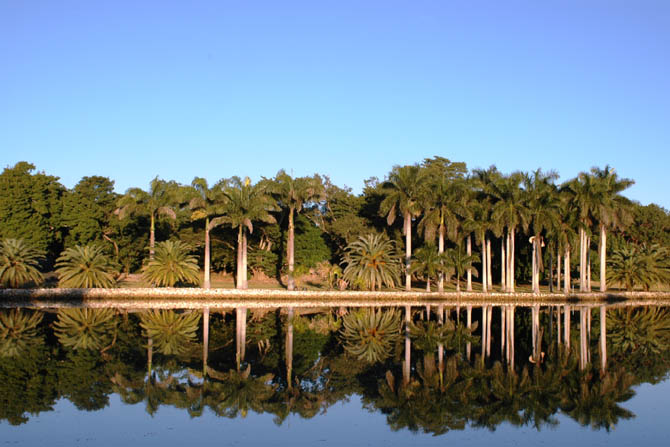
View across Royal Lake at
Montgomery Botanical Center

December
1-7, 2011
9th
International Conference on Cycad Biology:
Fairylake
Botanical Garden, Shenzhen, China
The 9th International
Conference on Cycad Biology was held in Shenzhen, China and
organized by Fairylake Botanical Garden,
the
Cycad Society of China, the
IUCN/SSC Cycad Specialist Group, the New
York Botanical Garden and Montgomery Botanical Center,
and co-organized by Shenzhen
Urban Management Bureau, Department of National Reserves &
Wildlife Conservation, the National Forestry
Bureau, and the China Wild Plant Conservation Association during
the week of Dec. 1-7, 2011. 
The conference
brought together over 100 delegates from 14 different countries,
including 50 cycad experts from China. Talks and posters were
presented in eight main study areas: Genetics and Genomics,
Conservation, Taxonomy and Phylogeny, Ecology, Horticulture,
Toxicology, Economic Botany, and Information Management. A total
of 54 talks and 22 posters were presented for a total of 76
presentations!
The conference
was held at the Shenzhen International Garden and Flower Expo Park,
which is run off a solar power grid, making this a very green
conference.
Montgomery
Botanical Center was well represented at the gathering, with MBC staff
authoring or co-authoring a variety of talks and posters -- from
genetics to horticulture:
-
A phylogeny
of Zamia, presented by Michael Calonje.
-
Thermogenesis
of cycad cones, presented by Irene Terry.
-
Microcycas
calocoma: conservation horticulture, presented by Patrick Griffith.
-
Conservation
genetics of Caribbean Zamia, presented by Alan Meerow.
-
Structural
evolution of cycads (Griffith).
-
Phenology
of Zamia, presented by James Clugston.
-
Conservation action plan for Zamia lucayana, (Michael
Calonje).
-
Evaluating
media for growth of Zamia species, presented by Chad Husby.
-
Botanic
gardens cycad collections, (Griffith).
-
Genetic
variation of the Zamia pumila complex, (Meerow).
-
Cycad
horticulture at MBC, presented by Stella Cuestas.
-
Assessing
coffee grounds to control cycad scale, presented by Tracy Magellan.
-
Cycad sex
ratios, presented by Claudia Calonje.
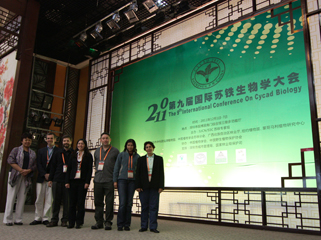 Many of MBC's research
colleagues also presented their work. A full list of presentations
including full titles, abstracts, and authors can be found in the
Special Issue of the
Journal of Fairylake Botanical Garden. 2011. Vol. 10(3-4). Many of MBC's research
colleagues also presented their work. A full list of presentations
including full titles, abstracts, and authors can be found in the
Special Issue of the
Journal of Fairylake Botanical Garden. 2011. Vol. 10(3-4).
This
conference allowed cycad biologists from around the world to present
new scientific discoveries and discuss critical future
directions. Central to the conference was the IUCN Cycad
Specialist Group, which met to update information on cycads on the Red List for 2011 with new data
gained from recent research.
This conference
was an immense success. Being able to hear about three years of
cycad research being conducted around the world at one conference was
spectacular. It is great to see the leaps and bounds being taken
by cycad biologists internationally.
The MBC Team would like to thank
the excellent people at Fairylake Botanical Garden for expertly hosting
this very important event.
November
2011
Fall/Winter
2011 Montgomery Botanical News is Now Online!
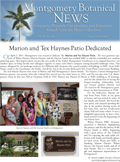 This new
issue has articles about collecting in The Bahamas, Florida, and
Brazil. It also highlights new infrastructure: the Marion and Tex
Haynes Patio. This new
issue has articles about collecting in The Bahamas, Florida, and
Brazil. It also highlights new infrastructure: the Marion and Tex
Haynes Patio.
Montgomery Botanical Center had
three undergraduate interns who did excellent work over the
summer. MBC also continued a tradition of excellent research
outcomes.
Montgomery
Botanical Center publishes two newsletters a year to keep our
supporters and collaborators up to date and informed. To read
more about how Montgomery Botanical Center meets our mission of
"Advancing Research, Conservation, and Education through Scientific
Plant Collections" please see our
newsletters online.
November
8, 2011
Dr. John Dowe Lecture on the
Flora of Australia at MBC
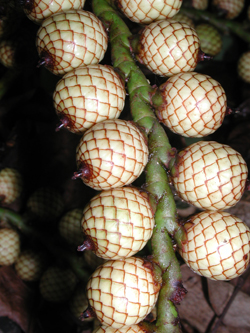 Where: Montgomery
Botanical Center, Nixon Smiley Building, 11901 Old Cutler Road, Coral
Gables, FL 33156, United States Where: Montgomery
Botanical Center, Nixon Smiley Building, 11901 Old Cutler Road, Coral
Gables, FL 33156, United States
When: November 8,
2011 from 2:00-3:30pm
Dr. John Leslie Dowe, Adjunct
Research Fellow at James Cook University, Townsville, Qld, Australia
& Research Fellow at Montgomery Botanical Center, Coral Gables,
Florida will be presenting a lecture on the Flora of Australia.
Volume 39 of the Flora of Australia
was published in July 2011. The project proposes to provide a complete
account of the Australian flora, published progressively as individual
family treatments are completed. The first volume was published in
1981, and presently about half of the volumes have been completed.
Volume 39 contains the treatment of the palms of mainland Australia as
well as 16 other monocot families. The presentation will explain the
history and background of the Flora of Australia project, and will
introduce the Australian palms as well as two other important families
that the author has an interest in, the Pandanaceae [Pandans] and the
Araceae [Aroids]. The talk will focus on these three families as they
occur in Australia, and outline the species and their relationships.
Dr. Dowe's visit to Montgomery Botanical Center is sponsored by the
Kelly Foundation, as part of the Kelly Fellows Program, and with the
support of the City of Coral Gables.
November
4, 2011
Historic
Landscapes Group visits Montgomery
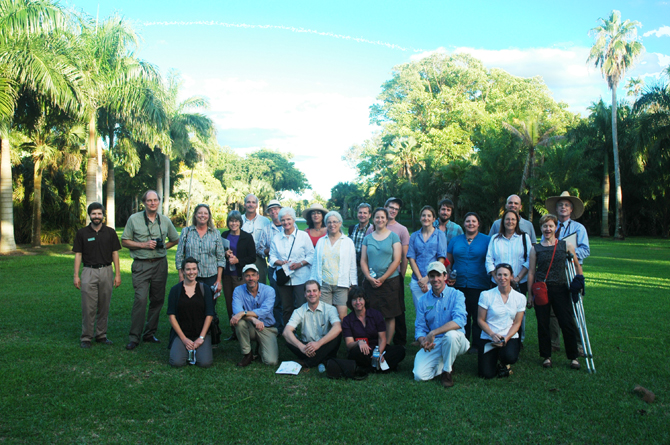
A group of
landscape architects and botanic garden professionals visited MBC as
part of the
Historic Landscapes Symposium, organized by the American Public Gardens
Association. The group visited MBC at sunset after a tour of The Kampong.
While at MBC,
the group learned about the history
of Colonel Robert and Nell Montomgery, the earliest days of the MBC
plant collection, and how the current team at MBC carries the
tradition forward with plant collecting work.
The group was comprised of professionals from as far away as
Connecticuit, Vermont, California, and Louisiana, highlighting the
great diversity of landscapes served by the APGA.
The symposiusm
was expertly organized by Ian Simpkins of Vizcaya Museum and Gardens.
One of the highlights of the tour was Microcycas calocoma, a
plant collection with an interesting shared history involving both
Montgomery and Vizcaya.
October
29, 2011
Hurricanes Help the Hometown
at MBC
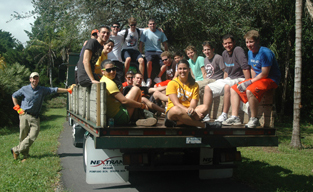 On Saturday, October
29th, 2011, twenty-five students from the University of Miami came to MBC for
Hurricanes Help the Hometown, an annual tradition where UM students
volunteer locally during the week of Homecoming. On Saturday, October
29th, 2011, twenty-five students from the University of Miami came to MBC for
Hurricanes Help the Hometown, an annual tradition where UM students
volunteer locally during the week of Homecoming.
This year the
fraternity Alpha
Epsilon Pi (AEPi) put in a day of work at Montgomery Botanical
Center. The students weeded around rare palms and conifers to keep the
weeds from out competing our valuable plants for nutrients.
After clearing
out many weeds, the group helped fill a dump truck with palm fronds
that had blown off the trees during an overnight storm.
Montgomery
Botanical Center looked greatly improved after their visit and we are
very thankful for their help.
October
23-28, 2011
Montgomery
at International Botanic Garden Workshop in Haiti
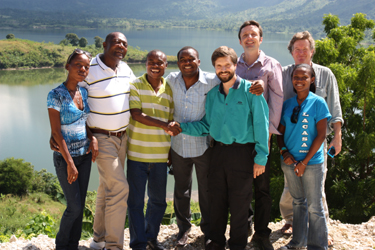 From 23-28 October, an international workshop
was held in Port au Prince, Haiti, to explore establishing a
national botanical garden to further conservation, education,
environmental restoration, and economic development in Haiti.
Botanic gardens from US, Canada, France, Scotland, Haiti and
the Dominican Republic participated in the workshop, which was
supported by the Haitian government and organized by William Cinea of
the Cayes Botanical Garden in Haiti. From 23-28 October, an international workshop
was held in Port au Prince, Haiti, to explore establishing a
national botanical garden to further conservation, education,
environmental restoration, and economic development in Haiti.
Botanic gardens from US, Canada, France, Scotland, Haiti and
the Dominican Republic participated in the workshop, which was
supported by the Haitian government and organized by William Cinea of
the Cayes Botanical Garden in Haiti.
Dr.
Chad Husby of MBC gave a
presentation on the role of botanic gardens in conserving rare
plant species and preventing their extinction. Since Haiti has
many extremely rare plants, some of which are reduced to only a handful
of individuals, a national botanic garden would have a crucial role to
play in conserving the endangered botanical treasures of the country
and paving the way for their eventual reintroduction to the wild.
MBC already conserves one very special Haitian endemic palm, Attalea
crassispatha, the only oil palm native to the Caribbean.
After the workshop presentations, participants spent two days visiting
potential sites for a botanical garden as well as natural areas in
Haiti. MBC looks forward to working with Mr. Cinea and Cayes
Botanical Garden on plant conservation projects.
September
30, 2011
New Paper:
William Lyman Phillips’ Landscape Design at Montgomery
A new paper by
the Montgomery Team appears in the September 2011 issue of Studies in
the History of Gardens & Designed Landscapes. The paper, titled: Principles and principes: William Lyman
Phillips and the palm collection at Montgomery, discusses
how Phillips’ design had an early impact on the landscape at MBC, and
how the design has been conserved over the decades.
Phillips’ innovative work was
wonderfully chronicled by his biographer, Faith Reyner Jackson, in the
book Pioneer of Tropical Landscape Architecture.
Jackson’s work detailed the many landscapes Phillips designed in Coral
Gables and elsewhere, and his hands-on approach to his art. Jackson
showcased Phillips’ work at Matheson Hammock, Crandon Park, Fairchild,
and at the Panama Canal.
Yet, one important landscape
that remained to be considered was Colonel Montgomery's Palm
Collection, where Phillips had a important, unique influence. Now, as a
botanic garden with a major emphasis on continued development of plant
collections, keeping that design at Montgomery requires a special
vigilance. Quoting from the paper:
"For a garden led by botanists,
with a mission of plant collecting, balancing the demand to plant
extensively with the design needs for space, contrast, consistency, and
variety require this guidance. Even in conserving an old design, a
garden is never finished. Beyond the basic work to maintain the
collection and landscape, continuing reassessment of the guiding vision
keeps that treasured landscape from slowly fading."
Studies
in the History of Gardens & Designed Landscapes is
considered a leading peer-reviewed journal in its field, and approaches
botanic gardens from a humanities perspective. The journal is
“established as the main place in which to publish scholarly work on
all aspects of garden history."
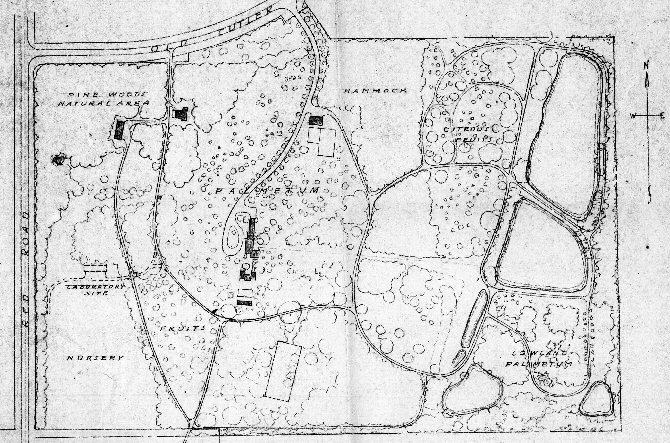
September 21, 2011
Public Lecture at MBC:
Dr. Irene Terry On the Pollination Biology of Cycads
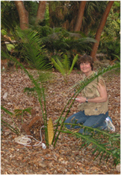 Dr. Irene Terry recently
offered a lecture at Montgomery, titled: Pollination biology of the Australian
cycad Macrozamia lucida and Guam's Cycas micronesica. Dr. Irene Terry recently
offered a lecture at Montgomery, titled: Pollination biology of the Australian
cycad Macrozamia lucida and Guam's Cycas micronesica.
Dr. Terry is an expert on cycad
pollination biology, and has closely studied the mutual relationship
between cycads and their pollinators. Through innovative methods, Dr.
Terry has advanced our understanding of how cycads attract pollinators,
and has brought to light aspects of cycad cone biology. Cycad cones
sometimes produce abundant volatile compounds, which give them
sometimes very distinctive fragrances. Additionally, the cones heat up
significantly during the reproductive phase, which facilitates
attracting the pollinators. Quoting from Dr. Terry’s recent research:
“the reproductive organs of some plants self-heat, release scent, and
attract pollinators. The relations among these processes are not well
understood, especially in the more ancient, nonflowering gymnosperm
lineages.”
Dr. Terry’s
visit to MBC is sponsored by the Kelly Foundation, as part of the Kelly
Research Fellows Program, and with the support of the City of Coral
Gables.
August 29, 2011
New paper: Remote Sensing as a Botanic Garden Tool
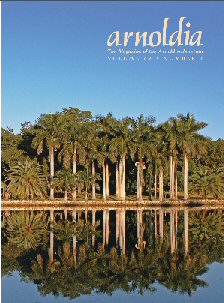 The latest issue of Arnoldia features a 'cover
article' by the MBC Team. The study offers examples of ways in
which
remote sensing can advance and improve the work of botanic gardens. The latest issue of Arnoldia features a 'cover
article' by the MBC Team. The study offers examples of ways in
which
remote sensing can advance and improve the work of botanic gardens.
The
paper details how LIDAR data of ground elevation and canopy height,
along with other imagery, were integrated into exisitng GIS (mapping)
systems at Montgomery, allowing for detailed assessment and analysis of
the grounds and plant collections. The new technology also opens new
avenues for garden-based research.
Ericka Witcher, lead author on
the study, states: "GIS technology has other uses at botanical gardens
beyond keeping track of our stuff through maps. Sharing techniques and
practical applications can help all of us make greater use of our
resources."
Quoting from the article:
"The ability to use remote
sensing data in conjunction with map files opened up entirely new ways
of visualizing the garden property. Tree canopies were accurately
identified by species by overlaying the mapped plant points onto the
orthophotos. Map files of road edges and lake boundaries from 10 years
before were adjusted to align with their current locations. Instead of
looking at information imposed on a representation of the property, the
information was examined in view of the property as a whole in the real
world."
Arnoldia is
the quarterly magazine of the Arnold
Arboretum of
Harvard University. The Arnold Arboretum is the oldest public
arboretum
in North America as well as an important center for plant science and
botanic garden innovation.
August 19,
2011
New paper on Microcycas calocoma:
An example of Conservation through Cultivation
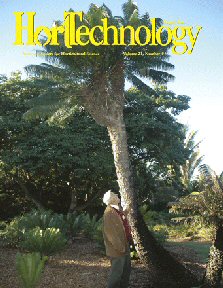 A new paper by
the Montgomery team is the 'cover
article' in the August issue
of HortTechnology. Titled Palma Corcho: A Case
Study in Botanic Garden Conservation Horticulture and Economics,
the study details the history of the Microcycas
collections at MBC, and methods used for successful
propagation of the species. A new paper by
the Montgomery team is the 'cover
article' in the August issue
of HortTechnology. Titled Palma Corcho: A Case
Study in Botanic Garden Conservation Horticulture and Economics,
the study details the history of the Microcycas
collections at MBC, and methods used for successful
propagation of the species.
The paper also looks carefully
at the economics of this species, via results from the MBC-FNGLA
online auction. Microcycas
calocoma is a very popular and highly sought after plant, but is
difficult to grow. Making this species widely available can help to
lower the price of the plants by meeting the high demand. Lowered price
should correspond to reduced incentive for poaching of wild plants.
Quoting from the study:
". . . overcollection of wild
plants is one factor leading to imperilment of natural
populations.Thus, propagation and distribution of palma corcho can make
a strategic contribution to in situ conservation. Provenance history of
the living collections is reviewed, and techniques for propagation and
establishment are detailed. An innovative botanic garden/industry
partnership to provide seed for cultivation is discussed. Finally, we
present analysis of market forces with regard to rare plant
availability and conservation, using palma corcho as an example."
Judy Kay, lead author on the
study, has been managing the Montgomery
Seedbank since 1998. Judy has fine-tuned a specialized protocol for
propagating this cycad over the years, and sharing that protocol is one
of the major goals of the paper. Judy states: "one of the best things I
can do is to help other gardens propagate their Microcycas. MBC has sent pollen out
to many places, and I always enjoy going to give demonstrations on the
pollination method."
August
12, 2011
James
Clugston from the Royal Botanic Garden Edinburgh
Talks Phenology
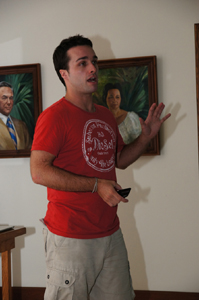 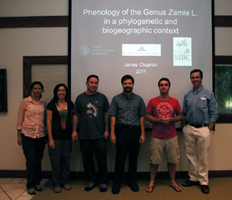 James Clugston, MBC's
newest Kelly Botanical Research Fellow, visited MBC for three weeks to
study the phenology of cycads. James Clugston is a 4th
year student in Horticulture with Plantsmanship at Royal Botanic Garden
Edinburgh (RBGE). His
research compares phenological data from wild herbarium specimens to
phenological data in a garden collection from information in the MBC
database. James Clugston, MBC's
newest Kelly Botanical Research Fellow, visited MBC for three weeks to
study the phenology of cycads. James Clugston is a 4th
year student in Horticulture with Plantsmanship at Royal Botanic Garden
Edinburgh (RBGE). His
research compares phenological data from wild herbarium specimens to
phenological data in a garden collection from information in the MBC
database.
On this project,
James Clugston is working with Zamia primarily, due to their
large numbers in our collection and in herbarium collections. But, he
is also deeply interested in South African cycads, Encephalartos
in particular.
James Clugston
is also working on this project with Dennis Stevenson and Damon
Little at The NYBG. We look forward
to good outcomes from this collaborative research.
August
11, 2011
UM-HOPE
Students Help Reconfigure Landscape Design
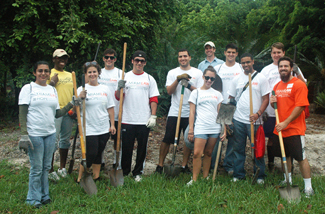 In changing times
garden design and practices have changed little by little at MBC.
One example is the raised beds constructed for the cycads in the 1990s.
Their drainage was poorer than anticipated and many cycads did not
thrive as well on these mounds as those planted at ground level. With
one of the world's largest cycad collections, many species planted at
MBC are often new to horticulture. In changing times
garden design and practices have changed little by little at MBC.
One example is the raised beds constructed for the cycads in the 1990s.
Their drainage was poorer than anticipated and many cycads did not
thrive as well on these mounds as those planted at ground level. With
one of the world's largest cycad collections, many species planted at
MBC are often new to horticulture.
With time we
learned to fine-tune the planting process and are now working on
leveling off beds and trying to keep the area of the beds tight,
allowing us to better maintain them while minimizing the use of
herbicide. Large mulched areas in full sun require a lot of labor
to maintain. Smaller beds with denser plantings are more
efficient.
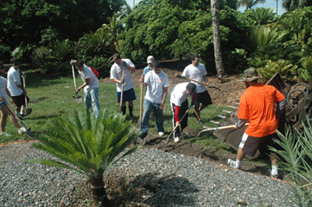 Nine new HOPE Public Interest
Resource Center law student volunteers from the University of Miami came to MBC to help
us with the hard work involved in removing rock mulch and reshaping
some landscape beds. The nine students were some of the fastest
and fittest volunteers we have had. They removed at least seven
loads of mulch and sand from the bed that was configured. Nine new HOPE Public Interest
Resource Center law student volunteers from the University of Miami came to MBC to help
us with the hard work involved in removing rock mulch and reshaping
some landscape beds. The nine students were some of the fastest
and fittest volunteers we have had. They removed at least seven
loads of mulch and sand from the bed that was configured.
After the
project, the students took a walking tour of the property to learn
about the plant collection and conservation work.
MBC is deeply
grateful for large-scale volunteer projects. These projects make quick
changes with long-lasting benefits. Thank you UM-HOPE students!
August
10, 2011
NSF
Intern, Nicolas Espinosa, Gives Final Report Talk
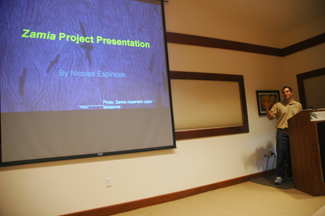 MBC is currently
supported by a National Science Foundation (NSF) grant with FIU,
USDA, NYBG, and FTBG to support Zamia
research in the Caribbean. Part of the grant supported the hiring of a
student intern. Nicholas Espinosa, a student at Florida
International University and an alumnus from the
Fairchild Challenge program, was hired to help with the research. MBC is currently
supported by a National Science Foundation (NSF) grant with FIU,
USDA, NYBG, and FTBG to support Zamia
research in the Caribbean. Part of the grant supported the hiring of a
student intern. Nicholas Espinosa, a student at Florida
International University and an alumnus from the
Fairchild Challenge program, was hired to help with the research.
Nicolas
Espinosa rotated among the institutions and worked approximately one
month at each location learning the specifics of horticulture,
herbaria, and microscopy. Nicholas learned how to care for a living
collection, press and mount herbarium specimens, and prepare slides
(scroll down to the May 9 item to see more about Nicolas' work at MBC).
Nicholas was
proud to announce during his lecture that he would be majoring in
Biology after his time interning. He deeply enjoyed learning
about the different aspects of botany.
July
26-29,
2011
Zamia
lucayana Outreach in The Bahamas

The Mohamed bin Zayed Species
Conservation Fund recently supported a large collaborative project
to study and conserve the Endangered Bahamian cycad, Zamia
lucayana. The project brought together experts from The Bahamas
National Trust (BNT), Florida 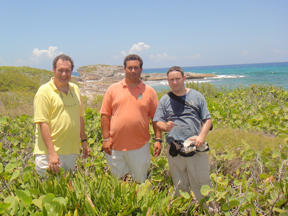 International
University (FIU), Fairchild Tropical
Botanic Garden (FTBG),
the United States Department of Agriculture (USDA),
and Montgomery Botanical Center (MBC), for a highly
successful collaboration. Herbarium specimens, seeds, locality data,
and DNA samples were collected from this very rare species endemic to
Long Island. International
University (FIU), Fairchild Tropical
Botanic Garden (FTBG),
the United States Department of Agriculture (USDA),
and Montgomery Botanical Center (MBC), for a highly
successful collaboration. Herbarium specimens, seeds, locality data,
and DNA samples were collected from this very rare species endemic to
Long Island.
Public
lectures were presented at meetings at the Retreat Garden National Park
in Nassau and at the Community Center on Long Island. Dr. Javier
Francisco-Ortega presented a lecture about Tropical Botanical Research
and Education at FIU and FTBG, Tracy Magellan presented a 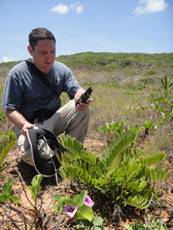 talk about MBC’s ex situ
conservation program, Michael Calonje (MBC) presented a talk about
Bahamian zamias emphasizing our findings with Zamia lucayana,
and Lindy Knowles presented a talk about the Bahamas National Trust. talk about MBC’s ex situ
conservation program, Michael Calonje (MBC) presented a talk about
Bahamian zamias emphasizing our findings with Zamia lucayana,
and Lindy Knowles presented a talk about the Bahamas National Trust.
The audiences
were highly engaged in the findings, and interested to learn their
local Zamia, known as “Bay Rush,” was a globally rare
species. Informational posters and postcards were distributed to
environmental and governmental agencies, to the Long Island Museum, and
to several schools for distribution to students at the start of the
school year.
The outreach
team returned to the Zamia lucayana populations which were
visited at the start of the project one and a half years ago, and were
pleased to find that the habitat remained intact. However, some of the
land including Zamia lucayana plants may change ownership
in the near future. The broad outreach in this project can help reach
the important future stewards of this living treasure.
The Zamia
lucayana project was a highly successful project bringing together
all the components of Montgomery Botanical Center’s mission of
supporting research, conservation, and education.
July
6, 2011
The
Villagers Support the Arthur Montgomery Guesthouse Restoration Project
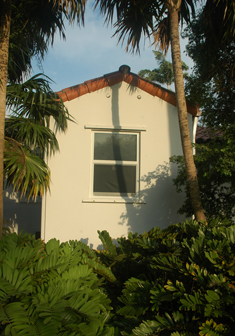 The Villagers of
Coral Gables have supported many historic preservation projects around
town, with four projects focused on the restoration of the Arthur
Montgomery Guesthouse. The most recent project supported the
replacement of thirteen windows. William Medellin,
architect and consultant for the Institute for Museum and Library
Studies (IMLS) and Heritage Preservation's
Conservation Assessment Program (CAP), The Villagers of
Coral Gables have supported many historic preservation projects around
town, with four projects focused on the restoration of the Arthur
Montgomery Guesthouse. The most recent project supported the
replacement of thirteen windows. William Medellin,
architect and consultant for the Institute for Museum and Library
Studies (IMLS) and Heritage Preservation's
Conservation Assessment Program (CAP),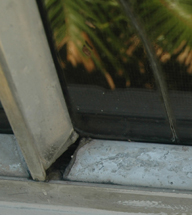 suggested replacing the
broken glass to prevent rainwater infiltration and repairing a wind
jamb that had plaster damage in his assessment of our historic
structures. suggested replacing the
broken glass to prevent rainwater infiltration and repairing a wind
jamb that had plaster damage in his assessment of our historic
structures.
Mr. Medellin
also noted hairline cracks above multiple window headers. Thanks to his
observations, the structural problems were noted and The Villagers
supported the restoration.
The Arthur
Montgomery Guesthouse now has 13 new hurricane proof windows, which
will surely last for the next 75 years. Montgomery Botanical
Center thanks The Villagers for their continued support.
May 19, 2011
Kelly Research Fellow and Palm Expert, Dr. Fred
Stauffer:
Studies Montgomery’s Palm Collection and Offers Lecture
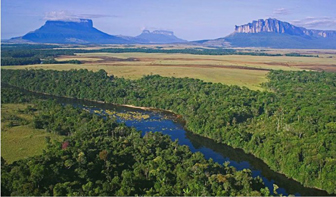 On May 19, Dr. Fred
Stauffer gave a public lecture titled, “Palms of Venezuela:
Diversity, Ecology, and Conservation.” Dr. Stauffer is Curator at
Conservatoire
et Jardin botaniques de la Ville de Genève,
Switzerland. His lecture focused on the history, floristics,
systematics, conservation, and potential uses of these palms, and also
added an overview of the
Jardín Botánico de Caracas, where a unique collection
of palms was developed through decades of work by
August Braun. On May 19, Dr. Fred
Stauffer gave a public lecture titled, “Palms of Venezuela:
Diversity, Ecology, and Conservation.” Dr. Stauffer is Curator at
Conservatoire
et Jardin botaniques de la Ville de Genève,
Switzerland. His lecture focused on the history, floristics,
systematics, conservation, and potential uses of these palms, and also
added an overview of the
Jardín Botánico de Caracas, where a unique collection
of palms was developed through decades of work by
August Braun.
Two hundred years ago Humboldt (German) and
Bonpland (French) collected palms in the Venezuelan Amazon. These
collections are housed in European herbaria, with many lectotypes in
the de Candolle Herbarium in Geneva. Dr. Stauffer carries this palm
research tradition forward, and in addition to fieldwork and herbarium
study, Dr. Stauffer makes extensive use of botanic garden living
collections. While at Montgomery this month, Dr. Stauffer
dissected, studied and documented a great variety of palms in flower,
remarking that the living collections here were a great resource for
his research. 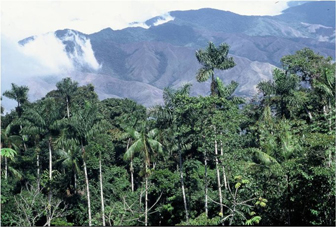
Venezuela has over 15,000 known plant
species and 261 families. With three distinct ecosystems—Caribbean,
Guayanan, and Andean—Venezuela is especially rich in palm diversity,
with 30 genera, 106 species, 1 subspecies, and 34 varieties.
Dr. Fred Stauffer is the most recently named
Kelly Research Fellow at MBC. The Kelly Foundation’s generous support
of this program allows experts from around the world to make use of the
MBC living collections for their scholarship, and to share their
findings with the botanical community, students and the public through
lectures. Please join MBC in thanking the Kelly Foundation for their
support of plant research and education.
May 14, 2011
The Palm Beach Palm and Cycad Society Visits Montgomery

There are many great clubs one can belong
to, but only the most dedicated will drive two hours to visit a plant
collection! 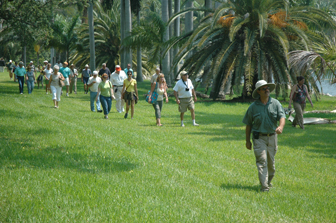
Over 40 members of the Palm Beach Palm and
Cycad Society visited Montgomery Botanical Center for a lecture and
tour of one of the world’s finest Palm and Cycad collections on May 14.
Montgomery Botanical Center cherishes
collaborations with local, national, and international societies. To be
able to share information on new science and discoveries with
interested parties is a wonderful way to meet Montgomery's education
mission.
“It's great to make friends with people who
share our two main interests: Palms and Cycads,” said Executive
Director Patrick Griffith. “I was thrilled that so many dedicated
people traveled from two counties away to see our collection.”
May 12, 2011
Canadian Plant Expert Studies Cycad Cones at Montgomery
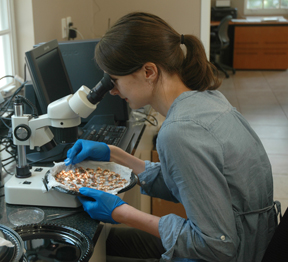 Natalie
Prior from the University of Victoria in Canada is visiting Montgomery
Botanical Center for one month to study cycads. Natalie has been
working with Dr. Patrick Von Aderkas collecting pollination drops from
cycads and analyzing their components. Natalie
Prior from the University of Victoria in Canada is visiting Montgomery
Botanical Center for one month to study cycads. Natalie has been
working with Dr. Patrick Von Aderkas collecting pollination drops from
cycads and analyzing their components.
For pollination to occur in most gymnosperms, a pollination drop is
used to deliver pollen into the female cone. The main function of
the drop is to receive the pollen, but interestingly it has been
discovered that these drops contain many organic and inorganic
components, such as sugars and free amino acids. In many conifers,
proteins have also been found. The main
hypotheses for these proteins are that they function as defense
mechanisms or antifreeze.
Montgomery Botanical Center is happy to welcome Natalie Prior and is
looking forward to seeing what's inside a pollination drop!
May 9, 2011
National Science Foundation
Intern Nicolas Espinosa Begins Tropical Zamia Project at MBC
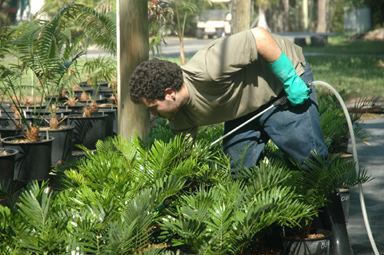 This year Montgomery Botanical Center, along with FIU and
the USDA, received a National Science Foundation grant titled,
“Phylogeography and conservation genetics of the Caribbean Zamia
clade.” This grant funding is supporting the investigation of
patterns of genetic variation in the Caribbean populations of Zamia
throughout their range using microsatellite DNA markers. This
research is testing the convergence of genetics and evolutionary
history. This year Montgomery Botanical Center, along with FIU and
the USDA, received a National Science Foundation grant titled,
“Phylogeography and conservation genetics of the Caribbean Zamia
clade.” This grant funding is supporting the investigation of
patterns of genetic variation in the Caribbean populations of Zamia
throughout their range using microsatellite DNA markers. This
research is testing the convergence of genetics and evolutionary
history.
NSF Intern Nicolas Espinosa, currently an undergraduate at Florida
International University focusing on environmental studies and biology,
is working at MBC, Fairchild, and the USDA to learn about the different
topics associated with tropical zamias.
The Caribbean Islands form a biodiversity hotspot with global
conservation priority. This research will outline conservation
strategies for Caribbean cycads, which are all endangered species.
Please join us in celebrating this great achievement and welcoming
Nicolas to the team.
May 4, 2011
Conifer
Expert Lectures at MBC
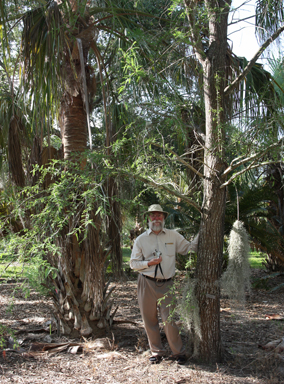 On May 4th, MBC hosted a
seminar by Dr. James Eckenwalder, entitled "Rethinking Conifers".
Dr. Eckenwalder is Associate Professor of Ecology and Evolutionary
Biology at the University of Toronto and his studies focus on
systematics of gymnosperms, poplars and Convolvulaceae (morning
glories). In 2009, Dr. Eckenwalder published the first modern
comprehensive taxonomic treatment of the world's conifers, entitled "Conifers
of the World." On May 4th, MBC hosted a
seminar by Dr. James Eckenwalder, entitled "Rethinking Conifers".
Dr. Eckenwalder is Associate Professor of Ecology and Evolutionary
Biology at the University of Toronto and his studies focus on
systematics of gymnosperms, poplars and Convolvulaceae (morning
glories). In 2009, Dr. Eckenwalder published the first modern
comprehensive taxonomic treatment of the world's conifers, entitled "Conifers
of the World."
From April 29 to May 5, Dr. Eckenwalder has been exploring warm climate
conifer collections in Georgia and Florida. Montgomery Botanical
Center was the final leg of his trip and allowed him to study the
rapidly growing tropical conifer collection on the property, which now
constitutes over 200 species (ca. 30% of the world's conifers).
Dr. Eckenwalder's career began on the MBC property, where he worked as
a taxonomist for Fairchild Tropical Garden from 1977-1978 and stayed in
the apartment of the Fairchild research building. During his time
in South Florida, Dr. Eckenwalder donated to MBC several plants he
collected of the Montezuma Bald Cypress, Taxodium mucronatum, the
national tree of Mexico, that he collected in the wild in Durango,
Mexico, in 1974. Of these original plants, one has survived to
the present day and graces the conifer collection at MBC (see photo).
During his seminar, Dr. Eckenwalder presented an overview of the
diverse forms of the world's conifer and emphasized that there is no
such thing as a "typical conifer". In addition, he highlighted
the many things that remain to be learned about conifers. Despite
the intensive study of northern timber species, many of the world's
conifers have received little attention, especially in tropical
regions. Although there are relatively few species of conifers
remaining on earth (545 by Eckenwalder's reckoning), new species are
being described on a regular basis. Much remains to be learned
about the ecology and physiology of conifers, including how they will
perform in different regions.
The conifer collection at MBC is providing a laboratory for discovering
which species are best adapted to South Florida. This continues
the tradition of Col. Robert Montgomery's early conifer trials at MBC
in the late 1930's and Dr. John Popenoe's conifer plantings in the
1970's. During his visit, Dr. Eckenwalder noted the importance of
diverse living collections, such as those at MBC, for better
understanding conifers.
May 3, 2011
Fairchild Challenge Brings Students to MBC for Environmental
Immersion Day
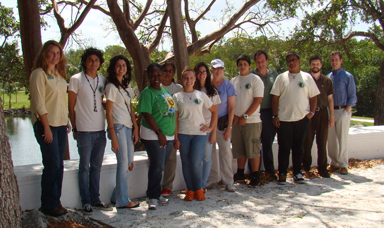 Ten students from Hialeah-Miami
Lakes Senior High School visited Montgomery Botanical Center as
part of the Fairchild Challenge’s Environmental Immersion Day. Ten students from Hialeah-Miami
Lakes Senior High School visited Montgomery Botanical Center as
part of the Fairchild Challenge’s Environmental Immersion Day.
The students participated in activities, focused on cycad biology with
four rotations lasting approximately 50 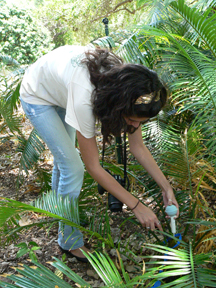 minutes. Judy Kay
taught students about pollination and seed development of cycads, in
theory and practice, collection of seeds, checking for embryos and
viability, and pollen collection and storage. Vickie Murphy gave
students hands on experience with cycad conservation practices in the
nursery. Dr. Chad Husby introduced students to features that
characterize cycads and differentiate them from other plant groups.
Ericka Witcher took soil cores at different sites on the property and
described the soil layers and their properties to the students. minutes. Judy Kay
taught students about pollination and seed development of cycads, in
theory and practice, collection of seeds, checking for embryos and
viability, and pollen collection and storage. Vickie Murphy gave
students hands on experience with cycad conservation practices in the
nursery. Dr. Chad Husby introduced students to features that
characterize cycads and differentiate them from other plant groups.
Ericka Witcher took soil cores at different sites on the property and
described the soil layers and their properties to the students.
One student is an aspiring botanist and was thrilled to be visiting a
botanic garden for Environmental Immersion Day. We were thrilled
to expose such and interested group of young students to botany at MBC.
April
30, 2011
Key West Garden Club at Montgomery
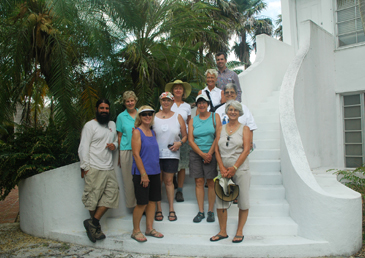 Eight visitors from the Key West Garden Club and
one Fairchild Tropical
Botanic Garden employee visited Montgomery for a
tour of the collections of palms and cycads. Eight visitors from the Key West Garden Club and
one Fairchild Tropical
Botanic Garden employee visited Montgomery for a
tour of the collections of palms and cycads.
The Key West Garden Club is a non-profit organization and one of Key
West's last remaining free tourist attractions. Plants are donated and
maintained by members and volunteers. A group of volunteers and members
drove three hours to visit Montgomery Botanical Center for a tour of
the collections of palms and cycads.
Montgomery Botanical Center has a history of donating plants to local
garden clubs and non-profits. Working together with organizations like
the Key West Garden Club helps to educate interested plant lovers in
the current conservation issues and research being conducted on palms
and cycads.
April
2011 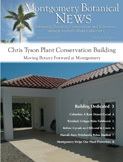
Spring/Summer
2011 Montgomery Botanical News is Now Online!
This new
issue has articles about collecting in Colombia, Trinidad, Belize,
and Hawaii. It also highlights new infrastructure: the Chris
Tyson Plant Conservation Building, the new Full Sun Nursery, and the
New Palm Shadehouse.
Montgomery
Botanical Center publishes two newsletters a year to keep our
supporters and collaborators up to date and informed. To read
more about how Montgomery Botanical Center meets our mission of
"Advancing Research, Conservation, and Education through Scientific
Plant Collections" please see our
newsletters online.
April
2, 2011
Marion
and Tex Haynes Patio Dedication
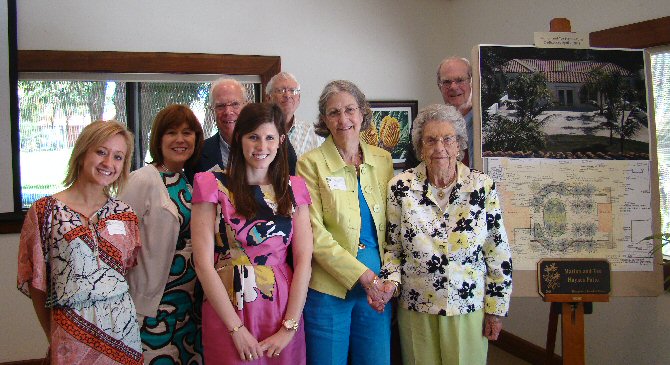
A highlight of
the 2011 Members Meeting was the dedication of The Marion and
Tex Haynes Patio. The very generous support of Walter
Haynes, Marion Haynes, and the Haynes Family has enabled MBC to add
this wonderful new outdoor gathering space. This improvement restores
the site to its original function back in Col. Montgomery’s time–a
place to bring friends and colleagues together. This project also fully
integrates the central complex of buildings at MBC, from Nell's House,
south to the Guesthouse, the Studio, and all the way to the Tyson
Building.
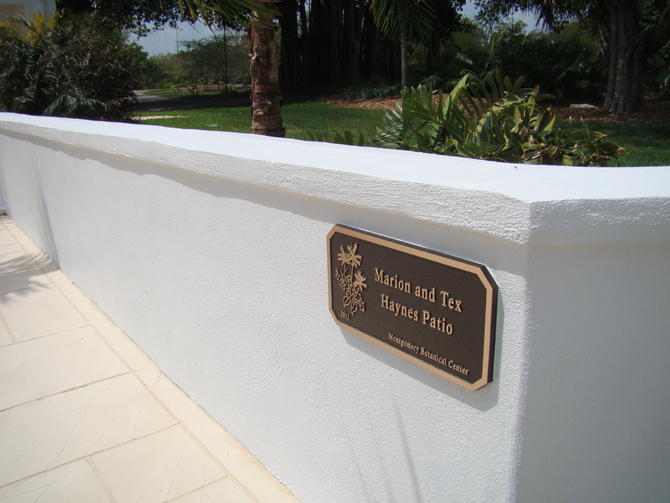 Tex and Marion Haynes
were some of Robert and Nell Montgomery’s closest friends. Marion
was Matron of Honor at Nell’s wedding to Al Jennings, and has the
distinction of having the longest-standing relationship with the
botanic garden here. Tex Haynes, Colonel Montgomery’s business partner,
was present when the Colonel first moved into the garden, and Tex was
also with Col. Montgomery when he first met Nell at Chapman Field in
1934. Tex and Marion Haynes
were some of Robert and Nell Montgomery’s closest friends. Marion
was Matron of Honor at Nell’s wedding to Al Jennings, and has the
distinction of having the longest-standing relationship with the
botanic garden here. Tex Haynes, Colonel Montgomery’s business partner,
was present when the Colonel first moved into the garden, and Tex was
also with Col. Montgomery when he first met Nell at Chapman Field in
1934.
Marion visited
from Jacksonville as MBC’s guest of honor, and was joined by many of
her family and friends. She loved the new patio, and enjoyed spending
the day in the garden, and sharing stories of her times here, and about
Nell and many others.
Walter Haynes,
MBC Treasurer, presented a slideshow highlighting the project, and also
the history of the Haynes family at MBC, beginning with a great photo
of The Colonel and Tex, along with B. Y. Morrison, and Isabel and Mac
Foster.
Please join
MBC in thanking Marion Haynes, Walter Haynes, and their family and
friends, for this very generous and important improvement to
Montgomery.
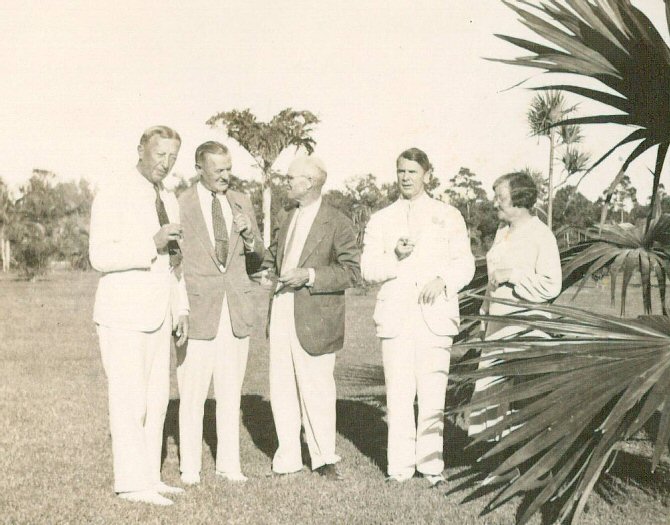
April
2, 2011
Members’
Day 2011
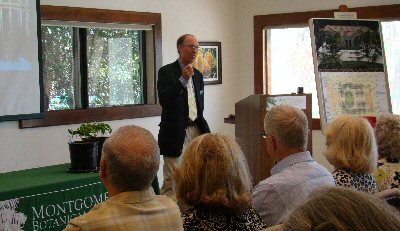 Montgomery Botanical
Center’s 52nd Members’ Meeting was held
Saturday April 2, 2011. The MBC Board of Directors announced
MBC’s new President, Nicholas Kelly. Charles P. Sacher, the
outgoing President, spoke about MBC’s accomplishments during his four
years as President and welcomed Mr. Kelly to his new position. MBC
elects a new President every four years, in keeping with Founder Nell
Montgomery’s wishes. Mr. Nicholas Kelly has served on the MBC Board of
Directors since 1996. He is President of Kelly Tractor. Nicholas
Kelly’s father Loyd, served as MBC President in the 1990s. Montgomery Botanical
Center’s 52nd Members’ Meeting was held
Saturday April 2, 2011. The MBC Board of Directors announced
MBC’s new President, Nicholas Kelly. Charles P. Sacher, the
outgoing President, spoke about MBC’s accomplishments during his four
years as President and welcomed Mr. Kelly to his new position. MBC
elects a new President every four years, in keeping with Founder Nell
Montgomery’s wishes. Mr. Nicholas Kelly has served on the MBC Board of
Directors since 1996. He is President of Kelly Tractor. Nicholas
Kelly’s father Loyd, served as MBC President in the 1990s.
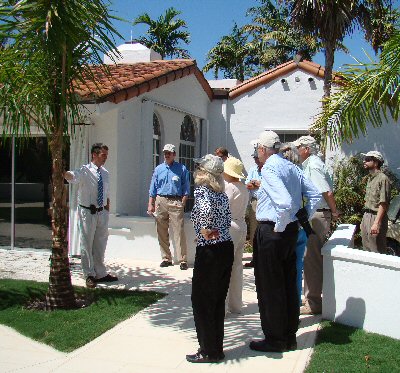
Dr. John
Popenoe resigned as Director, but retains his board-designated title of
MBC Botanical Consultant. The Board elected John’s daughter Dr. Juanita
Popenoe, extension faculty for regional commercial horticulture from
the University of Florida to serve as Director. Dr. Juanita
Popenoe grew up on the MBC landsite and has extensive experience with
the land and plant collections at MBC. Her horticultural
expertise brings an important perspective to the Board. Please
join MBC in welcoming her.
Reports were
made by Secretary-Treasurer Walter Haynes and Executive Director
Patrick Griffith. The Marion and Tex Haynes Patio was also dedicated at
the meeting. Please see the news item above for an account of this
important dedication.
A lecture was
presented by Dr.
Barbara Whitlock from the University of Miami, titled,
“Re-illuminating the Swingle Plant Anatomy Reference Collection.”
She described salvaging Walter Tennison Swingle’s plant anatomy collection, just
prior to it being thrown out. She also discussed making it
digitally available, to reach a broad group of users. Dr. Swingle
was an expert in citrus trees and Dr. Whitlock is currently using the
Swingle Collection to answer more hypotheses about that plant
family. 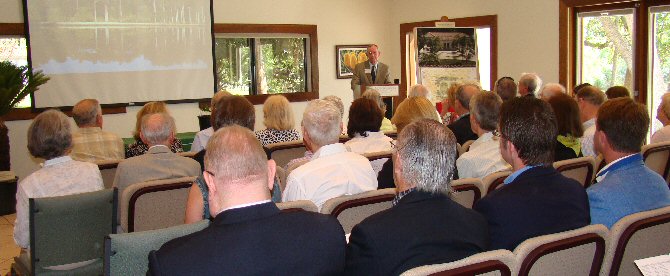
March 23, 2011
Zamia
Fieldwork Completed in The Bahamas
 The fieldwork component
of a multi-institutional collaboration focused on conducting research
on Bahamian Zamias has recently been completed. The field
research, conducted on five separate trips, included fieldwork on all
six islands in The Bahamas in which the genus Zamia
occurs. The fieldwork component
of a multi-institutional collaboration focused on conducting research
on Bahamian Zamias has recently been completed. The field
research, conducted on five separate trips, included fieldwork on all
six islands in The Bahamas in which the genus Zamia
occurs.
Research was
conducted on Long Island (December 2009), Andros (February 2010), New
Providence (March 2010), Eleuthera (March-April, 2010 and February
2011), Abaco (February 2011), and Grand Bahama (February 2011).
The Bahamian
research was funded by the Mohamed Bin Zayed Species Conservation Fund,
with additional funding for field research provided by Montgomery
Botanical Center. The field research was conducted in partnership
with the Bahamas National Trust (BNT)
by Dr. Javier Francisco-Ortega (Florida
International University [FIU], Fairchild Tropical Botanic
Garden [FTBG]), Dr. Alan Meerow (United States
Department of Agriculture [USDA]), Michael Calonje (MBC), Lindy
Knowles (Bahamas National Trust [BNT]), David Knowles (BNT), and
Camilla Adair (BNT). Additional field assistance was provided by Louis
Johnson, Sarah Gilmer, Russell Adams, and Claudia Calonje (MBC).
The field work
included collecting DNA samples for genetic studies that will be
conducted at Dr. Alan Meerow’s lab, herbarium specimens to document
wild Zamia populations, and seeds for ex-situ preservation.
During the
fieldwork in the Bahamas we found the genus Zamia to be much
more morphologically diverse than expected. For example, Zamia
angustifolia has the narrowest leaflets in the genus, whereas Zamia
lucayana has some of the widest leaflets among Caribbean Zamia.
The diversity of habitats in which Zamia occurs was also
quite surprising, as we found plants growing in pinelands, hardwood
coppice, shaded coastal sand dunes, and coastal scrub.
The fieldwork
resulted in a greater understanding of the distribution, ecology, and
conservation status of Bahamian Zamia, and the results of the genetic
studies will help clarify how different populations of Zamia
in The Bahamas are related to each other and to other similar taxa
found throughout the Caribbean.
South
Florida Palm Society 2011 Spring Palm Show and Sale at MBC
March 8, 2011
Dr. Angelica Cibrian, Kelly Research
Fellow at MBC
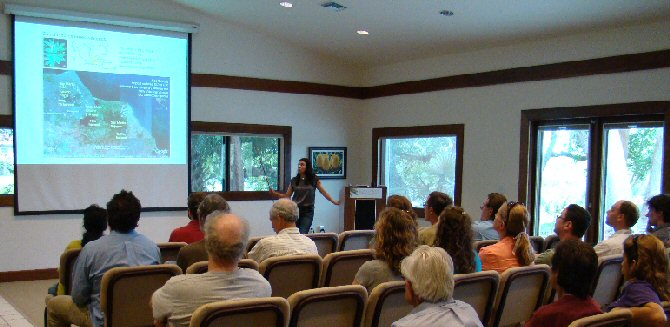 Dr.
Angelica Cibrian, from the New York
Botanical Garden, was hosted at Montgomery in early March as part
of the Kelly Research Fellows Program. Dr.
Angelica Cibrian, from the New York
Botanical Garden, was hosted at Montgomery in early March as part
of the Kelly Research Fellows Program.
Angelica offered a public seminar, titled: “The use of living collections to
understand plant evolution, from genes across landscapes to genomes
across species,” at the Nixon Smiley Meeting Room. Dr.
Cibrian’s lecture was well attended by colleagues from FIU, FTBG, the
horticulture community, and local plant enthusiasts.
During this trip to MBC she collected a diverse group of cycads and
conifers for ongoing broad studies of gene expression in plants that
will help us understand the evolution of the seed and traits of
agronomic importance in plants. This is part of her work with the New York Plant Genomics Consortium.
Angelica is working with Dr. Patrick Griffith on utilizing DNA data to
maximize the conservation value of botanic garden plant collections. Angelica recently chaired a
symposium on this subject at the X Congreso Latinoamericano de
Botánica in Chile.
Dr. Cibrian’s lecture also included insights on reintroduction:
“Botanical garden plant collections have helped us learn many important
things about plant evolution. One of the questions I am also looking at
now is how useful these collections can be for sources of seed for
reintroduction efforts.”
Dr. Cibrian has been using the living collection at MBC in her research
for many years. She has published on the population
genetics of Chamaedorea palms
in Belize and Cycas micronesica in the Western
Pacific. Both this palm and this cycad have specific conservation
concerns, from overharvesting and exotic pests, respectively.
The Kelly Foundation generously
funds our Fellows Program, which brings scholars to Montgomery to work
with our plant collections and the MBC Team.
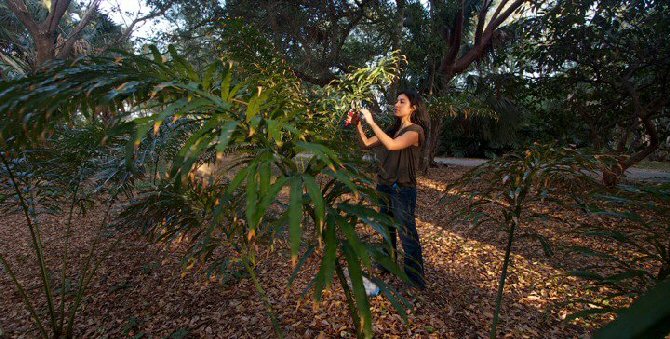
February 28, 2011
Caribbean cycad research funded by
National Science Foundation
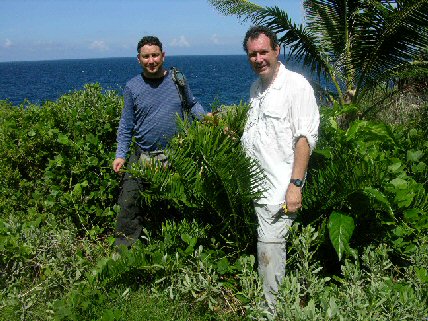 The
National Science Foundation has awarded
a $457,530 grant to a team of scientists from Montgomery Botanical Center, Florida International
University, Fairchild Tropical Botanic Garden, the United States
Department of Agriculture, and the New York Botanical Garden (Dr.
Javier Francisco-Ortega, Dr. Alan Meerow, Dr. Patrick Griffith, and Dr.
Dennis Stevenson) to conduct evolutionary and conservation genetics
studies of species of the cycad genus Zamia
from the Caribbean Islands. The
National Science Foundation has awarded
a $457,530 grant to a team of scientists from Montgomery Botanical Center, Florida International
University, Fairchild Tropical Botanic Garden, the United States
Department of Agriculture, and the New York Botanical Garden (Dr.
Javier Francisco-Ortega, Dr. Alan Meerow, Dr. Patrick Griffith, and Dr.
Dennis Stevenson) to conduct evolutionary and conservation genetics
studies of species of the cycad genus Zamia
from the Caribbean Islands.
The four Principal Investigators have a solid history of outstanding
and productive collaborations, and their institutions have a long
tradition of research concerning cycad biology and Caribbean Island
plants.
The project will involve (1) molecular studies coordinated by Dr.
Meerow; (2) field work and ex situ conservation, coordinated by Dr.
Griffith, in association with MBC Cycad Biologist Michael
Calonje; (3) graduate and undergraduate education coordinated Dr.
Francisco-Ortega; and (4) taxonomy coordinated by Dr.
Stevenson. 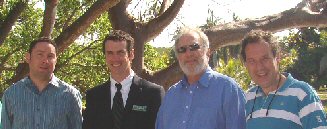
Importantly, the study also has
a strong secondary education component that will be carried out in
association with the Fairchild Challenge program. The project will be
done in close partnership with land managers and scientists from the
Greater Antilles and the Bahamas Islands.
Pictured here are Michael and
Javier with Zamia pumila in
the Dominican Republic, and Michael, Patrick, Alan, and Javier at
Montgomery.
February 24, 2011
Dr. Cristina Lopez-Gallego, Kelly
Research Fellow at Montgomery
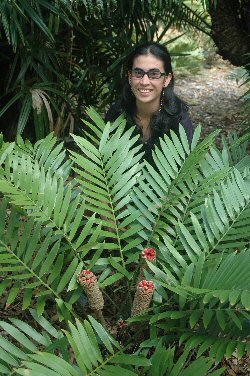 Dr.
Cristina Lopez-Gallego, Professor at the Universidad de
Antioquia, Medellin, Colombia, is being hosted at Montgomery as
part of the Kelly Research Fellows Program at MBC. Cristina is an
expert on the ecology and demographics of Zamia, and is a longtime
collaborator with the MBC Team. Dr.
Cristina Lopez-Gallego, Professor at the Universidad de
Antioquia, Medellin, Colombia, is being hosted at Montgomery as
part of the Kelly Research Fellows Program at MBC. Cristina is an
expert on the ecology and demographics of Zamia, and is a longtime
collaborator with the MBC Team.
While at MBC, Cristina continued
her work studying the phenological data on MBC Zamia collections and comparing
this to the extensive data on native cycads in Colombia and Costa Rica.
The timing of consecutive reproductive cycles, and how these relate to
new leaf production, is an area of recent interest for cycad studies.
Cristina offered a public
lecture on her work at MBC, titled "Exploring
the variation in life histories and population attributes in Cycads
using field studies and long-term data from botanical collections."
Quoting from Cristina:
"Cycads exhibit large variation
in their ecological features, like habitat, growth habit, reproductive
phenology, among others. With a growing number of studies about the
population biology of many cycad species across the world, we can begin
to explore how species from contrasting habitats and growth habits
differ in attributes like population density and stage-structure and
how these differences could be the result of variation in life-history
traits, for example related to allocation to fecundity and reproductive
schedules in general. In this talk I will present a research program
designed to investigate these questions about variation in life-history
and the effects of such variation on the population biology of cycads,
which could be interesting not only from a research point of view but
also because of potential applications for population conservation and
management."
Cristina, Michael Calonje and
Alvaro Idarraga are also studying a rare cycad from an arid part of
Colombia, Zamia encephalartoides.
Their project aims to determine conservation options for this species.
Please join MBC in thanking the
Kelly Foundation for their generous support of the Fellows Program at
MBC, which allows scholars to travel to MBC for study and research, and
to share this work through lectures.
February 4-5,
2011
NTBG 2011
Scientific Symposium: Co-Sponsored by MBC
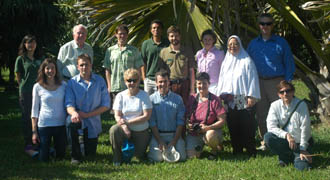 The National Tropical Botanic Garden at
the Kampong
awarded the 2011 David Fairchild Medal posthumously to Monty Beekman.
Dr. Beekman’s medal was accepted by Faith Foss, Professor Beekman’s
widow. The National Tropical Botanic Garden at
the Kampong
awarded the 2011 David Fairchild Medal posthumously to Monty Beekman.
Dr. Beekman’s medal was accepted by Faith Foss, Professor Beekman’s
widow.
 Dr. Beekman was
professor emeritus at the University
of Massachusetts Amherst and was recognized for his achievement in
translating
The Ambonese Herbal, Volumes 1 through 6,
published by Yale
University Press in collaboration with NTBG. Dr. Beekman was
professor emeritus at the University
of Massachusetts Amherst and was recognized for his achievement in
translating
The Ambonese Herbal, Volumes 1 through 6,
published by Yale
University Press in collaboration with NTBG.
Dr. Peter Raven, president emeritus of Missouri Botanical Garden, and Dr.
Henk van der Werff, Deputy Director of Research of Missouri Botanical
Garden, presented the keynote address for the symposium. Speakers
included: Dr. Pieter Baas from the
Netherlands Center for Biodiversity, Dr. Eric J. Buenz from Biosciential LLC, Dr. Michael
R. Dove from Yale University, and Dr.
Elizabeth A. Widjaja from
Herbarium Bogoriense.
Montgomery Botanical Center and the John C. Gifford Arboretum
of the University of Miami were
co-sponsors of the event. MBC was happy to show our work to such an
important group of distinguished visitors.
January 20, 2011
Cycad Paleontologist Gives Talk at
MBC
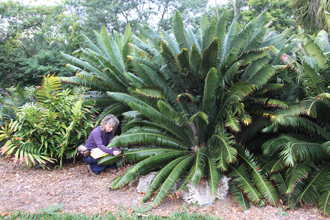 Dr. Boglarka Erdei from
the Hungarian
Natural History Museum presented a lecture at MBC titled, "Fossil
Cycads from the Cenozoic of the Northern Hemisphere." The
Hungarian Natural History Museum has 200 employees and a herbarium with
1.5 million herbarium sheets. The museum also contains a rare
collection of wooden books made of tree trunks containing vegetative
and reproductive structures. Dr. Boglarka Erdei from
the Hungarian
Natural History Museum presented a lecture at MBC titled, "Fossil
Cycads from the Cenozoic of the Northern Hemisphere." The
Hungarian Natural History Museum has 200 employees and a herbarium with
1.5 million herbarium sheets. The museum also contains a rare
collection of wooden books made of tree trunks containing vegetative
and reproductive structures.
Dr. Erdei will
be working as a Fulbright Scholar for three months at the Florida Museum of Natural History
at the University of Florida in
Gainesville.
Dr. Erdei has
been studying micro and macromorphological characteristics of fossil
cycads. Though much of the macromorphological characteristics are
identical, the micromorphological characteristics of the extinct cycads
when compared to their extant relatives are quite different. Dr. Erdei
looks at the location of stomata and the guard cells associated with
them, along with other micromorphological characteristics.
Visitors to the
lecture enjoyed seeing the similarities and differences between the
fossilized remains and present day cycads. Many fossilized cycads
were originally though to be fossilized ferns, due to their similar
macrostructure, but after close and careful observation this
identification was shown to be inaccurate.
Cycad Biologist
Michael Calonje states, "It is amazing that such exquisite detail can
be found in the micromorphology of fossilized cycad remains from
millions of years ago. At MBC, Dr. Erdei was able to utilize our living
cycad collection to quickly compile a database of samples of extant
cycad species for comparative studies with extinct fossilized cycads.
We were happy to see Dr. Erdei utilize our cycad collection in such a
novel and interesting way."
January 13, 2011
Plant
Paleontologist Studies MBC Collections
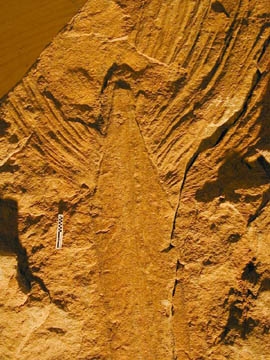 Paleontologist Kevin
Aulenback gave a seminar at MBC entitled, “Conifers, Cycadeoids and
Palms of the Horseshoe Canyon Formation, Alberta, Canada, with a new
interpretation of fossil conifer leaf arrangement.” This
presentation focused on the plants of the formation that link most
closely with MBC’s living collection. Aulenback began discussing a
fossil plant often interpreted as a true cycad, however, he presented a
strong case for the actual identity of the plant as a cycadeoid in the
order Bennettitales, which has a markedly different cone structure that
distinguishes it from modern cycads. Paleontologist Kevin
Aulenback gave a seminar at MBC entitled, “Conifers, Cycadeoids and
Palms of the Horseshoe Canyon Formation, Alberta, Canada, with a new
interpretation of fossil conifer leaf arrangement.” This
presentation focused on the plants of the formation that link most
closely with MBC’s living collection. Aulenback began discussing a
fossil plant often interpreted as a true cycad, however, he presented a
strong case for the actual identity of the plant as a cycadeoid in the
order Bennettitales, which has a markedly different cone structure that
distinguishes it from modern cycads.
Kevin
Aulenback studied MBC’s cycad and palm collections to gain insights
into the connections between modern and fossil floras. He is a
noted expert on the Cretaceous period flora and fauna of the extensive
Horseshoe Canyon Formation (68-72 million years old) and is the author
of the book
Identification Guide to the Fossil Plants of the Horseshoe Canyon
Formation (University of Calgary Press). This formation
is known as a rich site for dinosaur and plant fossils.
Kevin
also discussed other gymnosperms found in the formation, including
ancient relatives of modern conifers. Because interpretation of
fossil fragments of conifer shoots is often challenging, he used
observations on living conifers to develop a theory of how leaf
arrangement varies within and between plants. This provides
insights that can clarify understanding of the structure of both modern
and extinct conifers.
The
presentation concluded with a discussion of a fossil discovery that
constitutes the most northerly occurrence of a palm in North
America. This palm shows affinities in leaf structure to the
genus Sabal. Another fossil palm from a later period
has been found in Alberta with affinities to Serenoa, and
yet another formation has yielded fossil palm seeds. Although
these had been thought to be related to Nypa, examination of
MBC’s living Nypa collections convinced Aulenback that the
fossil seeds are not related to modern Nypa.
The
talk highlighted the importance of careful observation of living plants
for an accurate understanding of fossil plants. This underscores
the importance of living collections, such as those at MBC, for
understanding both current and ancient plant diversity.
MBC
News Archive
2005 2006 2007 2008 2009 2010 2011 2012 2013 2014 2015 2016 2017 2018
|



